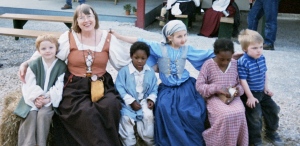Read a Story Storyteller Mary Garrett — Stories Make the World Go Around
THE FIREFLIES
from Bedtime Stories by Daddy John (Fussner)
(collected by his daughter, Mary Garrett)
One day, some little bugs went out to play. They were having a wonderful time. They played tag, hide-and-go-seek, follow-the-leader, and many other games that little boys and girls play. Oh, they were having such a good time, when suddenly a swarm of big mean bugs came along and chased the little bugs away. All day long, whenever the little bugs started to play, the big mean bugs would chase them away.
After the sun went down and it got dark, the little bugs thought that they would go play. The little bugs could see well at night, that is, well enough not to run into trees or anything. The big bugs, however, c ould hardly see at all. They had to find a good, safe place to spend the night. The little bugs flew around for a while, not having very much fun. The little fairies were out playing in the moonlight. They were having a wonderful time. The fairies love to run, jump, and dance in the moonlight. The Old Man in the Moon was in a happy mood, filling the woods and meadows with bright moonlight. The stars were bright and shiny, making it a wonderful, happy, carefree night.
The Fairy Queen heard a couple of little bugs talking. She stopped dancing to ask what was troubling them. They told her about the big bugs chasing them so they couldn’t play by day, and at night they couldn’t see each other well enough to have very much fun.
“Well,” said the Fairy Queen, “you do have a problem.” She thought for a while and then asked the little bugs, “Do you like to play at night?”
“Oh yes,” answered the little bugs, “it’s nice and cool, and the moon and stars are so pretty that we just love to play at night.”
“I have it,” said the Fairy Queen. “Let all these little bugs have lights in their tails so they can see each other in the dark.”
From then on, even until now, the little bugs can be seen at night, blinking their tail lights. Everywhere, children like to catch them. If you catch fireflies (or lightning bugs, as some people call them) don’t hurt them. Play with them for a while and then turn them loose again so they can have their fun.
This story, and others like it, are in chapbooks of my father’s stories:
Bedtime Stories by Daddy John (Fussner) 35 pages
“sweet dreams,” stories of fairies and nature.
Stories from the Land of Make Believe by Daddy John (Fussner) 53 pages
Dough Doughy and friends build a church, face a blizzard, enjoy life.
Homespun Stories from Uncle John 32 pages
Old time tall tales in dialect: mosquitoes big enough to eat a car, a mixed-up hen, pet skunks
$10 each or all 3 for $25
For more information about these chapbooks, as well as my CDs of stories, click on photo, or “CDs and Books” link, or click HERE to go directly to that page.
Frog Poem/Song from my friend Lucy Grondahl in honor of Prince
Twinkle Twinkle little frog,
Sitting in your slimy bog.
Munching on a Doozle Berry.
Thinking of your MaMa Mary,
Telling all your froggy kids,
What your Mama Mary dids.
Fed you crickets, ants and grubs,
Gave you froggy tummy rubs.
Every baby froggie-poo,
Wants to visit Mary too.
The Honey Dance from Stories from the Land of Make Believe
One day Dough Doughy was lying out in the back yard, watching the clouds. Did you ever look at the clouds and see different things? If you look very close, you can see ‘most anything: fish, boats, faces, and lots of different things. As Dough Doughy lay there, he saw a bee fly over. It wasn’t a cloud bee but a sure-enough real one. To read the rest
Grandpa’s Hired Hand from Homespun Stories from Uncle John
Grandpa’s homestead was ‘twixt two mountains in a narry valley. The ground was so poor that the subsoil came up to the third rail on the fence. The pasture was so sparse that the rabbits had to pack a lunch to cross it. The well water was so hard that he had to break hit with a hammer to fill a cup. To read the rest




